New Trend: Co-Living Space Enters Tianjin
By Lesley Chai, Assistant Manager at JLL Research Tianjin and Michael Hart, Managing Director at JLL Tianjin
 谈起共享经济,大家一定并不陌生:如果你想搭车出门,可以乘坐“滴滴打车”的快车,如果想短距离行动,可以方便地“扫一扫”骑共享单车出行。对于小型初创企业,还可以去到创业孵化器中,租一个简单的办公区域,与大家共享办公空间。如今,住宅也可以共享了,现在有很多地产项目针对年轻人群体推出了“共居”这一共享居住空间的租房选择。这一概念最早源于国外近年兴起的‘Co-living’,中文叫“共居”。它是在共享经济大潮下,由共享工作空间(Co-working Space)延伸出来的新鲜事。虽然形式依然是几个年轻人合住一屋,但是有别于普通租房,在分摊租金的同时还加入新概念,共同生活形成小社区,这一新模式切合新世代需要,极受欢迎,成为现代年轻人合租的新潮流。
谈起共享经济,大家一定并不陌生:如果你想搭车出门,可以乘坐“滴滴打车”的快车,如果想短距离行动,可以方便地“扫一扫”骑共享单车出行。对于小型初创企业,还可以去到创业孵化器中,租一个简单的办公区域,与大家共享办公空间。如今,住宅也可以共享了,现在有很多地产项目针对年轻人群体推出了“共居”这一共享居住空间的租房选择。这一概念最早源于国外近年兴起的‘Co-living’,中文叫“共居”。它是在共享经济大潮下,由共享工作空间(Co-working Space)延伸出来的新鲜事。虽然形式依然是几个年轻人合住一屋,但是有别于普通租房,在分摊租金的同时还加入新概念,共同生活形成小社区,这一新模式切合新世代需要,极受欢迎,成为现代年轻人合租的新潮流。
对于已婚人士或以家庭为单位的购买者,直接购买整套住房是他们的优先选择,在购买住房时,还会考虑子女入学的因素以及生活便利条件等等。但是对于一些刚刚毕业踏入社会的大学生,年轻白领以及单身人士而言,入学条件或一些区位因素并不重要,相反,距离工作地点的远近,设施的便利程度,以及舒适的室内装修和良好的社区环境,还有完善的公寓式家政服务等等因素才是吸引上述群体加入到共居概念之中、分享租金并成为共居租户的主要条件。
目前,共居生活理念已经在海外以及国内的大城市如上海、北京、深圳等地蓬勃发展;但是这种模式的租金回报率却低至2%。开发商对于共居概念大多还缺乏兴趣,缺乏新的建筑用地,政府法令法规的限制以及一些开发商保持自身固有的优势等都造成了这一住房模式推广的阻碍。另外,开发商除了开发楼盘,还需要承担社区管理者的角色,加大了他们的工作压力和工作内容,这些也都是共居概念推广过程中的新挑战。目前来看,共居概念的发展,在很大程度上取决于城市整体的经济增长以及政府的支持态度,还有市场参与者、年轻一代的接受程度。天津即将迎来本市首个共居空间,让我们对它的表现拭目以待。
The sharing economy is booming and while initially welcomed only by young people, now it is gradually being adopted by the whole society. Shared bikes are on the street everywhere, Didi’s ride sharing is popular and its app is installed on almost every young person’s phone. You can also find work places with shared working environment and facilities. Co-working space which emerged recently and attracted young start-up companies and freelancers is available in Tianjin. But what about accommodation?
This sharing concept is finally expanding to the housing market. Co-living space is entering Tianjin after several years’ development in Tier I cities. It could be a new option for young people who don’t own an apartment.
What Is Co-Living Space?
Co-living space is a new form of rental housing. It is usually an apartment building run by a single operator, providing small-size but fully furnished units, public spaces and shared amentities with other services for young generations.
The main attraction or the main difference between co-living space and other types of housing (traditional residential and serviced apartment) is that co-living space provides a social environment for young people to thrive in. Thanks to common space, amenities and activities, renters have a better chance to meet people and make friends with their neighbours. In addition, to attract young people, co-living spaces often have trendy interior designs.
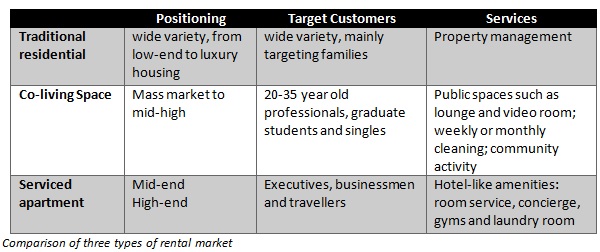 One of the main co-living space brands in China, Port Apartment, run by Vanke, plans to open its first project in south-west Tianjin in October. Vanke signed a 20-year lease contract with local government who owns the apartment building. In this nine-storey building, floors three to nine feature apartments for rent; the first floor is a retail podium and the second floor is the public area, including a communal laundry area, gym, billiards and video room. Port Apartment has already opened in 13 cities including Beijing and Shanghai. Residents can enjoy various community activities, such as community concerts, cooking competitions and Halloween Parties.
One of the main co-living space brands in China, Port Apartment, run by Vanke, plans to open its first project in south-west Tianjin in October. Vanke signed a 20-year lease contract with local government who owns the apartment building. In this nine-storey building, floors three to nine feature apartments for rent; the first floor is a retail podium and the second floor is the public area, including a communal laundry area, gym, billiards and video room. Port Apartment has already opened in 13 cities including Beijing and Shanghai. Residents can enjoy various community activities, such as community concerts, cooking competitions and Halloween Parties.
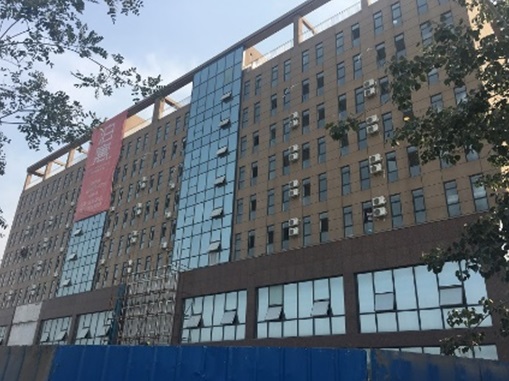
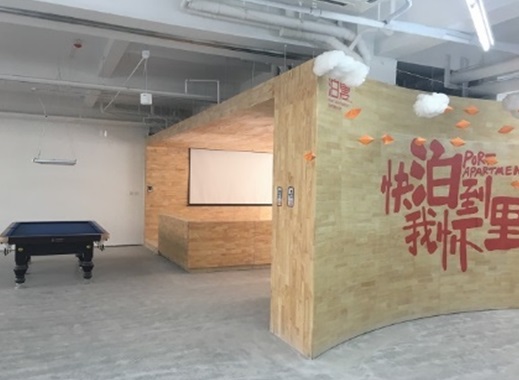 Port Apartment Tianjin under construction, façade and public space
Port Apartment Tianjin under construction, façade and public space
Need For Co-Living Space
In general, married couples and retired people tend to aspire to buy apartments in good school districts, near parks or with nearby amenities. They are looking for long term stability, something they can often do because their higher purchasing power allows them to buy a property. But for groups, including graduate students, young singles, professionals and young married couples, who may not yet have the required purchasing power to buy and don’t need to focus on children’s schools and want to be close to their workplace, renting for a few years is a good option.
They may also be more focused on aspects including nice interior decoration, additional services, a community environment and other social opportunities. Co-living space can fulfil most their requirements.
The concept of co-living is already popular in international locations including Silicon Valley and New York, with healthy economic growth and a thriving service industry where young professionals and startup companies are abundant. China is seen by many as a leading player in the techonology and sharing sectors and, as a result, we expect to see stronger demand for co-living space. In fact the new model started and quickly expanded to cities like Shanghai and Shenzhen several years ago.
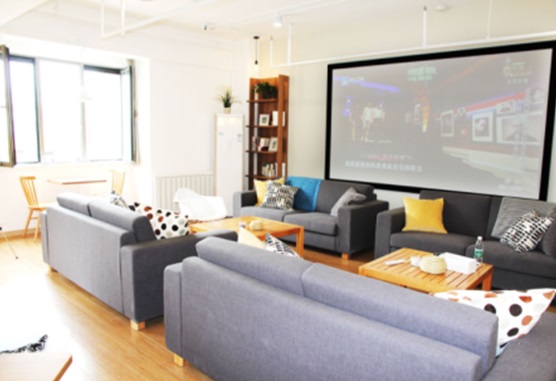
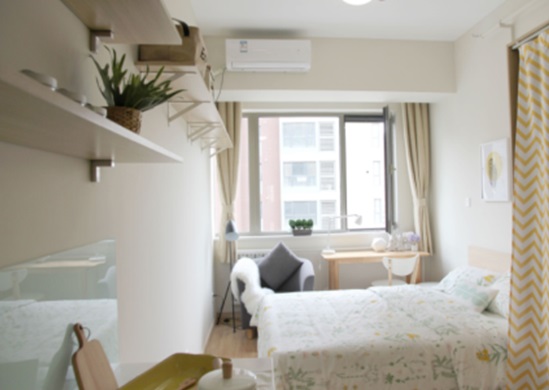 Port Apartment Beijing, video room and unit design
Port Apartment Beijing, video room and unit design
Why Are Developers Are Interested In Co-Living Space?
It is easy to understand why this model might appeal to end users, but why would traditional Chinese developers be interested in developing this product, since the yields appear to be lower than their traditional development for sale model. Some estimate rental returns on co-living space to be as low as 2%.
There are several reasons as to why traditional developers might be interested in Co-living space:
1. Lack of new land: Lack of new land for residential properties released by the government, especially in city centres make it more competitive for developers to obtain new lands.
2. Government regulation: Government released new rules for land auctions in Tianjin, setting maximum prices and once developers reach the celling price, they must turn to other options to win the land plots. By committing to not selling, but retaining the units for lease only, the government is favouring developers who will help increase the stock of apartments for rent, solving an ongoing challenge in major cities.
3. Government direction: Both central government and several local authourities have published several documents to encourage developers to add more rental properties into their portfolio. For example, Shanghai government plans to add 700,000 units of rental apartments including co-living space by 2020. Beijing and Nanjing governments have published interim measures for the administration of giving renters rights of schooling and medical services equal to homeowners.
4. Cheap alternative to new raw land: Because of the high cost of residential-use land and the difficulty of getting land from the government, an alternative for a developer is to purchase an existing commercial building and re-purpose it. This could be money-saving because, in some cases, price of an existing commercial building could be half the price of a new piece of land.
5. Diversify revenue stream: With land price and the cost of construction, labour and other costs growing, developer’s profit margins are expected to shrink. To stabilise revenue and add a new profit source as a supplement, developers start the new rental strategy and get ongoing income from rental apartments.
6. Focusing on their strengths: Most residential developers have their own construction teams, which means they are able to provide professional and trendy interior decoration for rental apartments.
Challenges For Development Of Co-Living Space Market
Traditional residential developers are used to the model of purchasing land, building the apartment blocks and selling them, so recouping their initial investments plus profits takes only a few years. In fact in Tianjin, rules allow developers to pre-sell units, thus bringing in funds even before the projects are completed. Building for the rental market is different. The initial construction and decoration costs will be substantial and result in lower income in form of rents which will squeeze developers profits merging in the first few years. At some stage however, a healthy portfolio of rental property will provide developers with a more steady stream of income, as opposed to the volatility of development related cash flows.
Managing a portfolio of co-living space will also require continuous management and maintainance. Besides the operator of the project, developers may also play the role of community leader. Some developers may not have enough experience in this area. For example, to maintain young customers and compete with traditional rental residentials, operators must follow trends, figure out what young people like and even host activites to improve the social fuction of co-living and build a neighbourhood in the building.
Another challenge is the lack of related laws to protect the rights of both sides. Chinese rules have generally focused on “for sale”, not “for rent” market and so renter protection while already less developed, will face bigger challenges with this new rental model.
Conclusion
Development of co-living space market will largely depend on a city’s economic growth, government’s support, innovation of market players and acceptance of this model by the younger generation. How to make housing affordable for most residents is a challenge for almost all major metropolitan areas, not only in China but the world over. Co-living space with its community and sharing concept may be the one of solutions, but it also has some uncertainties and challenges. As the first major co-living spaces open in Tianjin, this will be an interesting sector to watch.
---END---